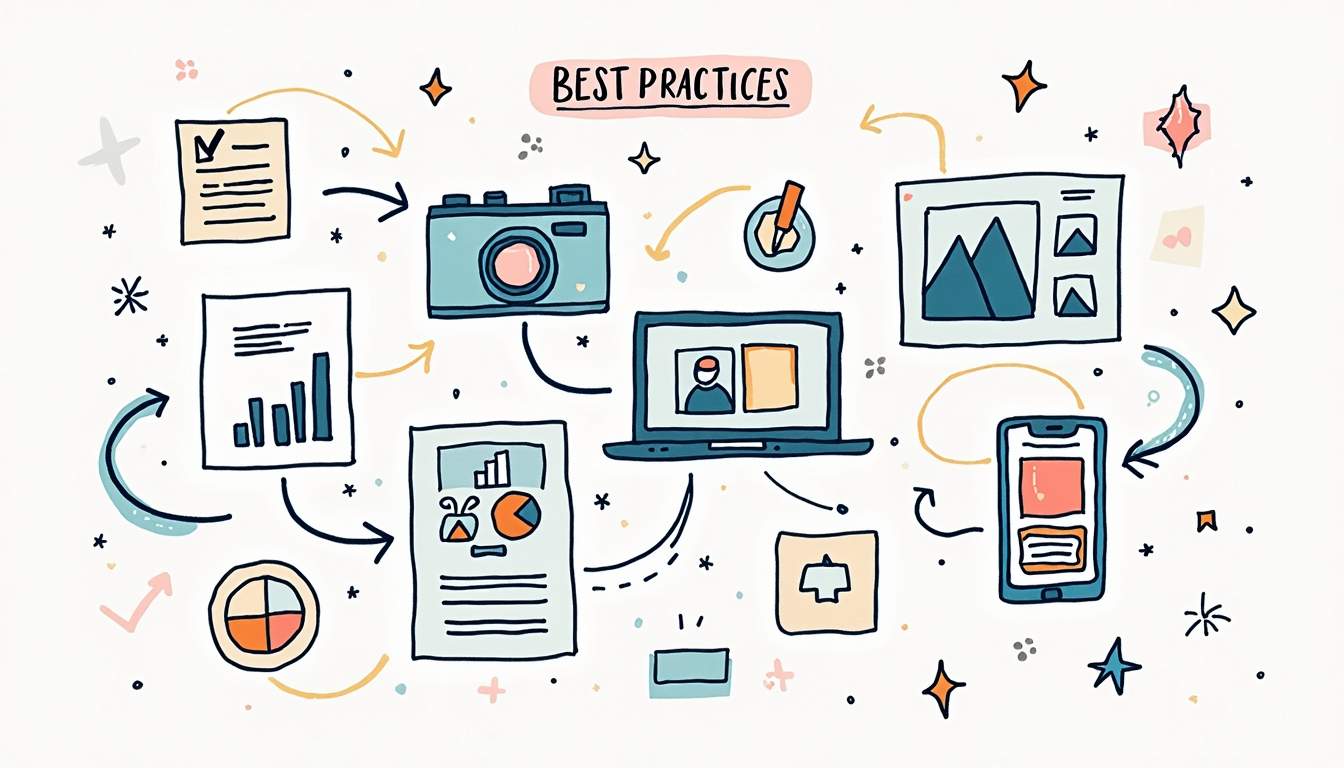User-generated content, commonly known as UGC, has revolutionised the way brands engage with their audiences. This comprehensive FAQ covers everything you need to know about UGC creation – from understanding the basics to hiring content creators, managing costs, and measuring results.
Understanding UGC Content
At its core, UGC is any content—be it text, videos, images, reviews, etc.—created by people who are not official representatives of your brand. This type of content can be a powerful tool for increasing brand transparency and authenticity.

What is UGC ?
UGC encompasses a wide range of content. From an Instagram post featuring your product to a blog review or even a YouTube unboxing video, this content is created by actual users of your products or services. It serves as a gateway to gaining genuine insights from real experiences.
The power of UGC lies in its authenticity. When potential customers see content from their peers, it resonates more deeply than traditional marketing. It builds trust, giving potential buyers a glimpse of real-life applications of your product or service.
Why is UGC Important for Brands?
Brands have increasingly turned to UGC because it acts as a bridge between businesses and customers, fostering a sense of community and trust. In fact, UGC is often seen as more trustworthy and reliable because it reflects actual consumer experience.
UGC has also been instrumental in driving brand awareness. With the widespread use of social media, a single post can gain significant traction, amplifying your brand’s reach and visibility. Furthermore, it reduces content creation costs as the material is coming from your audience.
Moreover, UGC can significantly enhance customer engagement. When brands actively encourage their customers to share their experiences, it not only boosts interaction but also creates a sense of belonging among users. This engagement can manifest in various forms, such as contests or campaigns that invite customers to showcase their creativity while using your products. Such initiatives not only generate a wealth of content but also foster loyalty, as customers feel valued and recognised for their contributions.
Additionally, UGC can provide valuable insights into customer preferences and behaviours. By analysing the types of content your audience shares, you can gain a deeper understanding of what resonates with them. This information can inform your marketing strategies, product development, and customer service approaches, ensuring that you are meeting the needs and expectations of your target audience. As a result, UGC not only serves as a marketing tool but also as a vital resource for continuous improvement and innovation within your brand.
UGC Content Quality & Performance

What makes UGC stand out?
Standout UGC combines several key elements to capture audience attention and drive engagement. Authentic storytelling that focuses on personal experience forms the foundation of compelling UGC, creating genuine connections with viewers. The most effective content maintains high production quality while preserving authenticity—polished enough to look professional but natural enough to be believable.
Successful UGC clearly demonstrates product benefits or solutions in real-world contexts rather than simply listing features. Creating emotional connections through relatability helps viewers see themselves using the product. Many standout UGC pieces employ creative or unexpected approaches to showcase products, breaking through content saturation.
The best UGC naturally integrates into the creator’s typical content style rather than feeling like an obvious advertisement. When calls to action are included, they flow naturally from the creator’s experience instead of feeling forced. Finally, unique perspectives that differentiate from standard brand-created content give viewers fresh reasons to engage with your products.
What are examples of high-converting UGC videos?
High-converting UGC videos typically follow proven formats that showcase products authentically while driving action. The problem-solution format is particularly effective, where creators identify a relatable pain point and demonstrate how your product provides the solution. This format creates immediate relevance for viewers facing similar challenges.
Day-in-the-life content shows natural product integration into daily routines, helping viewers envision the product in their own lives. Before-and-after transformations provide compelling visual evidence of results, particularly powerful for beauty, fitness, home improvement, and organisational products.
Authentic reviews that include both pros and cons paradoxically increase credibility and conversion rates compared to perfectly positive reviews. Unboxing videos capturing genuine first impressions satisfy curiosity about the purchase experience and initial quality.
Other high-converting formats include:
- Tutorial/how-to content demonstrating practical product usage
- Comparison videos showing advantages over alternatives
- Narrative-driven “storytime” content creates emotional connections
- Quick tips providing actionable advice incorporating the product
- Interactive “duet” style reactions responding to brand content with personal experience
The most successful videos combine these approaches with clear calls to action that feel like natural recommendations rather than sales pitches.
How do I measure UGC performance?
Measuring UGC performance requires tracking both engagement metrics and business outcomes. Engagement rates (likes, comments, shares) provide immediate feedback on content resonance, while conversion rates from UGC-driven traffic demonstrate actual business impact. Click-through rates specifically measure how effectively UGC prompts further action.
Time spent viewing UGC versus brand-created content offers valuable comparative data about what captures audience attention. Sentiment analysis of comments and reactions helps understand emotional responses to your content and products. The repurposing potential across multiple channels extends the value of your UGC investments.
For bottom-line impact, track:
- Sales directly attributed to specific UGC campaigns
- Cost per acquisition compared to other marketing channels
- Brand sentiment lift after UGC campaigns
- User retention and repeat purchase rates from UGC-acquired customers
Combine these metrics in regular reporting to create a comprehensive view of your UGC program’s effectiveness and ROI.
UGC Costs & Rates
What are typical UGC creator rates?
Rates vary based on creator experience, platform, and deliverable requirements. Nano-influencers with 1K-10K followers typically charge $50-$300 per post, while micro-influencers (10K-50K followers) command rates between $200-$800. Mid-tier creators with 50K-500K followers can charge anywhere from $800-$5,000 per post. Many brands also work with professional UGC-only creators who specialise in creating authentic content without necessarily having a large following themselves, usually charging $200-$1,000 per deliverable.
How do platform-specific UGC creator rates differ?
Platform-specific rates reflect the different production demands and audience engagement across social media channels. TikTok generally commands higher rates ($100-$1,000) due to its video production demands and viral potential. Instagram Reels are priced similarly to TikTok ($100-$800), while Instagram Stories typically cost less than feed posts ($50-$500). Standard Instagram Feed Posts serve as a baseline for many brands ($150-$600). YouTube content typically demands the highest rates ($500-$5,000+) due to higher production quality and time investment, while Pinterest content often costs less than Instagram ($100-$400).
How do I calculate the total cost of UGC content for my business?
Calculating the true cost of UGC requires accounting for all direct and indirect expenses associated with your program. Begin by determining your content volume needs based on your marketing calendar and channel strategy—for example, 10 videos per month. Next, factor in creator rates based on platform requirements and experience levels, which can vary significantly.
Don’t overlook product sampling and shipping costs, which can be substantial depending on product value and geographic distribution of creators. Most brands should allocate 15-20% of their UGC budget to program management time and tools, including creator communication, content review, and performance tracking.
For campaigns extending beyond social media, consider additional usage rights fees for expanded distribution across channels like website, email marketing, or paid advertising. Some creators charge premium rates for these extended usage rights.
A realistic monthly budget calculation might look like this:
- 10 TikTok videos @ $300 each = $3,000
- Product costs & shipping = $500
- Management time/tools = $600
- Extended usage rights = $1,000
- Total monthly investment = $5,100
When evaluating ROI, compare these costs against the production value and performance of brand-created content alternatives.
UGC Production Timeline & Process
How long does a typical UGC production process take?
A standard UGC production timeline typically spans 2-4 weeks from initial outreach to final implementation. The process begins with creator outreach and briefing, which generally takes 3-5 days to identify the right creators, establish communication, and align on expectations. Product shipping follows, requiring 2-7 days depending on location and shipping method.
Once creators receive products, the content creation phase takes 3-7 days as they familiarise themselves with the product, plan their approach, and produce the content. The review and feedback stage typically requires 2-3 days as your team evaluates deliverables and provides direction.
If revisions are needed, expect another 2-4 days for creators to implement changes and resubmit. Final delivery and implementation across your platforms usually takes 1-2 days. For complex campaigns involving multiple creators or requiring coordination among various stakeholders, the timeline may extend to 4-6 weeks.
What steps are involved in the UGC content production process?
- Strategy development and content planning
- Creator identification and outreach
- Contract negotiation and agreement
- Detailed creative brief development
- Product shipping and delivery
- Content creation
- Review and approval process
- Content delivery and rights transfer
- Implementation across platforms
- Performance tracking and analysis
How can I streamline the UGC production timeline?
Streamlining your UGC production process can significantly reduce timelines while maintaining quality. Building and maintaining a roster of pre-vetted creators eliminates the time-consuming outreach and evaluation phase for each new campaign. These creators already understand your brand voice and expectations, allowing for a faster turnaround.
Creating template briefs and contracts saves considerable administrative time and ensures consistency across campaigns. Many brands find that using digital product delivery when possible (such as service access, digital products, or expedited shipping options) can eliminate lengthy shipping delays.
Implementing clear feedback processes with specific guidelines and examples helps creators understand exactly what changes are needed, reducing revision cycles. Project management tools specifically designed for creator management can automate workflows and keep all communications in one accessible location.
For larger campaigns requiring significant coordination, consider working with specialised UGC agencies that have established processes and creator networks already in place. Their expertise can often compress timelines while delivering professional results.
Hiring UGC Creators
What should I look for when hiring UGC creators?
When hiring UGC creators, look for portfolio quality and aesthetic alignment with your brand to ensure a natural fit. Technical skills in video editing, photography, and writing are essential for professional-quality deliverables. Reliability and strong communication skills will make the collaboration process smoother.
Pay special attention to content engagement rates, which are often more important than follower count when assessing a creator’s influence. Make sure the job description exactly lists what you are looking for. The creator should demonstrate an understanding of your industry and target audience to create relevant content. Authenticity and storytelling ability are crucial for creating compelling UGC that resonates with viewers. Previous brand collaboration experience can indicate professionalism and adaptability to brand guidelines.
Where can I find qualified UGC creators?
Finding qualified UGC creators requires exploring multiple channels. The TikTok Creator Marketplace offers a centralised platform with verified creator metrics and direct outreach capabilities. Instagram remains valuable when you search relevant hashtags like #ugccreator or #contentcreator to discover talent.
Many brands leverage specialised platforms such as Twine, Upfluence, Grin, Fiverr and Aspire, which specialise in UGC creator categories. For ongoing campaigns, creator-focused job boards like CreatorJobs and HireInfluence can connect you with experienced professionals.
Additional sources include:
- UGC agencies and creator collectives
- LinkedIn (search for “UGC Creator” or “Content Creator”)
- Industry-specific Facebook groups
- TikTok hashtags like #ugcforbrand or #hireugccreator
- Referrals from other creators or brands
Legal and Practical Considerations
What legal considerations should I be aware of when using UGC?
Legal considerations are crucial when implementing UGC strategies to protect both your brand and its creators. Always obtain explicit permission before repurposing UGC across channels, even if it was originally created for your brand. This permission should be documented and stored securely.
Creating clear terms and conditions for UGC campaigns establishes expectations and rights for all parties involved. Many brands develop simple release forms specifically for content usage rights that clearly outline how, where, and for how long the content may be used.
Understanding platform-specific rules regarding UGC is essential, as each social network has different policies about content ownership and usage rights. When reusing creator content, proper attribution is both a legal consideration and a relationship-building practice.
Other important legal aspects include:
- Establishing clear compensation agreements for paid UGC
- Ensuring content complies with advertising disclosure requirements (like #ad or #sponsored)
- Respecting intellectual property rights of third parties that might appear in UGC
- Implementing processes to quickly address content that violates guidelines
Consider consulting with a legal professional specialising in digital content rights to develop standardised agreements and processes for your UGC program.
How can brands encourage more high-quality UGC?
Encouraging high-quality UGC requires strategic approaches that motivate your audience to create and share content. Start by creating branded hashtags that are easy to remember and use, enhancing discoverability and campaign cohesion. Many successful brands run contests with meaningful prizes that inspire creativity while generating a collection of usable content.
Featuring UGC prominently on your website and social channels shows appreciation and motivates others to participate. Regular acknowledgement and engagement with users who create content builds community and encourage continued participation. When providing guidelines, balance clarity with the creative freedom to get authentic yet on-brand results.
Consider these additional strategies:

- Offer incentives beyond monetary compensation, such as product samples or exclusive experiences
- Design “shareable moments” in your product experience and packaging
- Develop ambassador programs for consistent content creation
- Create physical spaces or pop-up experiences designed for content creation
- Respond to and reshare spontaneous UGC to encourage more organic participation
How should UGC fit into my overall marketing strategy?
UGC should be integrated throughout your marketing strategy rather than treated as a separate initiative. Effective integration means using UGC across the entire customer journey, not just during awareness phases. The most successful brands complement their polished brand-created content with authentic UGC to create a balanced content mix that appeals to different audience preferences and builds trust.
Strategic UGC deployment involves leveraging different types of user content for specific objectives. Use testimonials and reviews for trust-building, while product demonstrations and tutorials can drive conversions. Repurpose high-performing UGC across multiple channels to maximise ROI and create a consistent experience.
UGC provides valuable insights that can inform product development, helping identify feature requests, pain points, and unexpected use cases. Many brands find success by integrating UGC into paid advertising, which often improves performance metrics compared to traditional brand-created ads.
The most sophisticated UGC strategies create a feedback loop where user content influences broader brand strategy, creating an authentic, customer-centric approach to marketing that evolves with your audience’s preferences and behaviours.
Next Steps
Ready to elevate your brand’s UGC strategy? At Twine, we connect you with expert freelancers who specialise in UGC content creation. Our marketplace helps you find the perfect content creators for your specific industry needs, budget, and timeline requirements. Post your requirement for free to access a community of professional creators who can help you harness the authentic voices of your audience.




